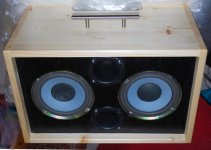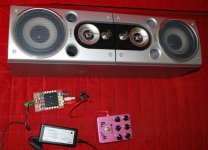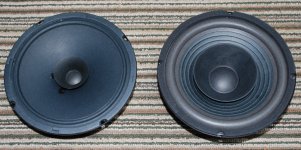Bass-reflex tuning effectively adds the mass of a plug of air in the port to the moving mass of the loudspeaker. The extra mass makes the final speaker Q in the enclosure (Thiele & Small called this Qtc) increase. Too high a Qtc, and you get boomy, one-note bass.So does bass-reflex have any use for guitar speaker boxes?
So, for use with a bass-reflex enclosure, to keep the bass from becoming boomy and peaky, the woofers must start out with a low Qts (typically between 0.3 and 0.5.)
Traditional guitar speakers don't fit this description - they often have a Qts as high as 1.0 or even higher. So they are not suitable for a ported enclosure.
However, if you're using unconventional speakers with guitar, porting may be appropriate. I have built two small guitar amp projects in the recent past, both using speakers taken from thrift-store boombox speaker enclosures. The original factory enclosures were ported to get good bass out of these relatively small drivers, so one presumes the drivers had appropriate Qts values.
In one case, I could not re-use the original ported boxes because of the amount of cosmetic problems they had, so I built my own box, but I kept the same port tuning - twice the internal volume, two identical ports, and two loudspeakers.
In the second case, the original speaker enclosures were in good condition cosmetically, and I was able to re-use them unmodified.
In both cases, the ports help these relatively small speakers provide good bass down to the lowest guitar notes.
I've attached a picture of each of these ported guitar enclosures.
-Gnobuddy
Attachments
Two 12" Cerwin Vega's in a Traynor horn loaded bass reflex cabinet. Used to have a pair of them.

Speakers came in a wide variety of flavours, some had higher Q than others, depends on the intended applications which got put where. If the Q close to 1.0 outside the cabinet then in a ported or a sealed cabinet it would really jump. Thankfully that is not always the case, I think it might even be rare. Just for kicks check out a Greenback in its usual sealed enclosure.
https://celestion.com/speakerworld/downloads/guitartech/141.pdf
Speakers came in a wide variety of flavours, some had higher Q than others, depends on the intended applications which got put where. If the Q close to 1.0 outside the cabinet then in a ported or a sealed cabinet it would really jump. Thankfully that is not always the case, I think it might even be rare. Just for kicks check out a Greenback in its usual sealed enclosure.
https://celestion.com/speakerworld/downloads/guitartech/141.pdf
Very interesting, Qts of ~0.4 and Fs of ~57 Hz? (That's far below the 83 Hz lowest note on a guitar.)check out a Greenback in its usual sealed enclosure.
Those numbers look as though this was originally designed as a P.A. speaker, which Celestion later pressed into service as a guitar speaker.
-Gnobuddy
Very interesting, Qts of ~0.4 and Fs of ~57 Hz? (That's far below the 83 Hz lowest note on a guitar.)
Those numbers look as though this was originally designed as a P.A. speaker, which Celestion later pressed into service as a guitar speaker.
-Gnobuddy
Nope, too much breakup. They intended them to go into a 4x12 cabinet and there is only so much speaker cabinet roadies were willing to carry. 😉
Most of the classic "guitar speakers" originated in the 1930s as either Big Radio or Small PA speakers. The early guitar-amp makers bought them from the standard products. Tried several to find tone and stamina.
Later that class of large speaker vanished, except in g-amps. Radios got smaller. PA moved to more specialized and analyzed designs from talking-movie roots. But those better 1930s radios had "tone" you don't get from precision or small cones.
The "breakup" is incidental. You don't run a 10 Watt radio at 10 Watts, usually under 1 Watt, so the 15-20W speaker was generous for the intended purpose, not when flogged with a 20W stage amp.
Later that class of large speaker vanished, except in g-amps. Radios got smaller. PA moved to more specialized and analyzed designs from talking-movie roots. But those better 1930s radios had "tone" you don't get from precision or small cones.
The "breakup" is incidental. You don't run a 10 Watt radio at 10 Watts, usually under 1 Watt, so the 15-20W speaker was generous for the intended purpose, not when flogged with a 20W stage amp.
I suspected as much. The 12" and 15" speakers in old floor-standing radios and radiograms seem identical to vintage guitar speakers.Most of the classic "guitar speakers" originated in the 1930s as either Big Radio or Small PA speakers.
I think there was one more branch on the radio / record player / P.A. side of the family tree after guitar speakers split off, and before the lineage died out - the "full range" speaker with its additional separate "whizzer" cone, otherwise still very similar to older large thin-cone, large diameter speakers.Later that class of large speaker vanished, except in g-amps.
There are still few of those dual cone full range speakers around, though rarely larger than 8" nowadays. I've tried a couple of them as guitar speakers with moderate success. They retain prices that match their crude simplicity, unlike contemporary guitar speakers, whose prices have soared into the stratosphere.
-Gnobuddy
Attachments
You have a typo there, or read too fast 😛 , actual Fs (open air) is 75 Hz.Very interesting, Qts of ~0.4 and Fs of ~57 Hz? (That's far below the 83 Hz lowest note on a guitar.)
Those numbers look as though this was originally designed as a P.A. speaker, which Celestion later pressed into service as a guitar speaker.
-Gnobuddy
https://celestion.com/productpdf.php?id=16
And in any reasonable cabinet it goes up (of course), from 90 to 100Hz in a 4 x 12", up to 110Hz in some very compact cabinet ... always closed back.
The heavier version, sometimes favored by Hendrix, was the way heavier G12H30, with the "Bass cone" which lowered resonance to 55Hz ... again unmounted.
All Fs rise 30/50% in a closed back cabinet of roadie-movable size.
As of tuning Guitar cabinets: I have tuned them, sometimes, not to increase Bass but to decrease cone excursion at resonance to reduce rattle, go figure.
With the Bass port/tube at the cabinet back.
Sorry, I should have been more clear. It was the G12H I was talking about - Printer2's link included measured data for a few specimens of the same speaker, each with a slightly different Fs. I picked 57 Hz as typical (didn't know the factory spec was 55 Hz.)The heavier version, sometimes favored by Hendrix, was the way heavier G12H30, with the "Bass cone" which lowered resonance to 55Hz ...
It was just by coincidence that the 57 Hz I picked happened to be the mirror image of the 75 Hz spec for the "other" Celestion G12! 🙂
I am a very odd electric guitarist, in the sense that I never had a community of other typical electric guitar players around me, and so I have still never even seen many of the speakers and amps that are a routine part of most electric guitar players lives.
Most of those speakers and amps are not usable in the settings in which I play electric guitar (too big, too loud, too heavy, too expensive), so I found my own way. My "big" amp is a '65 Princeton Reverb reissue. 😀
-Gnobuddy
I am a very odd electric guitarist, in the sense that I never had a community of other typical electric guitar players around me, and so I have still never even seen many of the speakers and amps that are a routine part of most electric guitar players lives.
-Gnobuddy
Playing a hole life exclusively my home brewn amps since I went to school, there are very few commercial amps I really checked intensely. I have the vague idea that I do not like fender amps nor eminence speakers - but this may be pre-bias as well.
I did the same for many years - but I built them like Hi-Fi amps, solid-state with low distortion. They all sounded horrible with my electric guitars, and I could not understand why.Playing a hole life exclusively my home brewn amps since I went to school
What confused me was that I could sound pretty decent with an acoustic guitar. But whenever I played an electric guitar through one of my amps, I sounded horrid.
The first time I sounded not-horrible with an electric guitar was when I plugged into a (Fender) Super Champ XD set to the clean channel. It was a shock, finding out that the route to good guitar sound (for my tastes) involved going back a hundred years, to a long-obsolete electronic device called the thermionic valve / vacuum tube.
Just recently I'm learning how to make solid-state electric guitar amps that sound not-awful...but it takes a lot more work and components than it does with a handful of 12AX7s and a pair of 6V6s!
-Gnobuddy
...but it takes a lot more work and components than it does with a handful of 12AX7s and a pair of 6V6s!
-Gnobuddy
Do not forget some hands full of transformers😀
- Status
- Not open for further replies.
- Home
- Live Sound
- Instruments and Amps
- 6" Guitar Speaker


